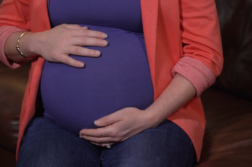BLOOMFIELD, Mich. (Ivanhoe Newswire)—Internal stimulators implanted to control pain have been around for years. But in the past, they had to be replaced about every four years when the battery died. Now, a new technology can keep patients out of the OR for decades. Rechargeable STIM
Taking up figure skating just shy of forty is hard enough. But doing so while suffering from interstitial cystitis is even harder. It’s a bladder condition that caused Heather Kettle, extreme pain.
“The pain I was experiencing was very intense abdominal pain, in through to my back, that would happen on a daily basis,” Kettle recalled.
To improve her quality of life, Heather had an internal stimulator, or STIM, implanted. Earlier versions had a battery life of three to four years. But a new, smaller one has a rechargeable Bluetooth battery that can last for up to 20 years. It’s charged externally, once a month.
“And you place this on your device, the device sits in your hip area and for 20, 25 minutes, it’s gonna charge. And it’s gonna let the patient know when the device is charged,” illustrated Urogynecologist, Dov Schuchman, MD.
STIM therapy works by placing a lead with electrodes on a nerve. This new version “talks” through a communicator to a controller—the STIM’s external brain. It has eleven programs to manage pain.
“Depending on how my pain is, I can turn the level up or I can turn to level down,” Kettle shared.
Heather says the device has made her a better skater. Previously, she could only handle five to ten minutes at a time on the ice before the pain became too intense to handle.
“Everything just works better when there’s no pain involved,” Kettle added.
She’s now able to take the steps needed to train for competition.
Another benefit to the new stimulator is that it is MRI safe. Older versions are not.
Contributors to this news report include: Cyndy McGrath, Executive Producer; Hillary Rubin, Field Producer; Roque Correa, Editor.
To receive a free weekly e-mail on Medical Breakthroughs from Ivanhoe, sign up at: http://www.ivanhoe.com/ftk
MEDICAL BREAKTHROUGHS
RESEARCH SUMMARY
TOPIC: RECHARGEABLE STIM ELIMINATES PAIN
REPORT: MB #4907
BACKGROUND: Interstitial cystitis, or bladder pain syndrome, is a chronic bladder health issue that leaves a feeling of pain and pressure in the bladder region. Symptoms can range from mild to severe and may come and go, but for some they don’t go away. Women with interstitial cystitis may feel pain when having sex, while others may experience health issues such as irritable bowel syndrome, fibromyalgia, and other pain syndromes. Interstitial cystitis is typically 2 to 3 times more common in women than in men, and data has shown the risk increases with age. The current estimate is that 1 to 4 million men and 3 to 8 million women have symptoms of interstitial cystitis.
(Source: https://www.urologyhealth.org/urology-a-z/i/interstitial-cystitis)
CAUSES AND DIAGNOSIS: It is not known exactly what causes interstitial cystitis, but some theories say it could be a defect in the bladder tissue, which may allow irritating substances in the urine to penetrate the bladder. Or, a specific type of inflammatory cell, called a mast cell which releases histamine and other chemicals that lead to symptoms. It could also be something in the urine that damages the bladder, or changes in the nerves that carry bladder sensations, so pain is caused by events that are not normally painful (such as bladder filling).
Finally, it could be the body’s immune system attacking the bladder. There is no medical test that says a person has interstitial cystitis. But there is also no test to say a person does not have it. To make a diagnosis, your health care provider will first decide whether the symptoms are typical of the disease. Next, they will rule out other health issues.
(Source: https://www.urologyhealth.org/urology-a-z/i/interstitial-cystitis)
NEW THERAPY WITH HOPE: Johns Hopkins University conducted a study of patients with interstitial cystitis/bladder pain syndrome where they attended an eight week mindfulness-based stress reduction course involving yoga and meditation. All participants had a negative urinalysis within two months of enrollment and were currently undergoing treatment at the time of recruitment. The course would meet weekly for one hour. A straight-catheter urine sample was obtained prior to and following the series. Researchers took the DNA from urine samples and underwent bacterial 16S ribosomal gene sequencing followed by taxonomic abundance and diversity analysis. A total of 12 participants completed the course and were included in the analysis where the average age was 59. Patient symptoms improved significantly, and the overall composition of the urinary microbiome changed significantly and demonstrated an increase in diversity following the intervention.
FOR MORE INFORMATION ON THIS REPORT, PLEASE CONTACT:
DOV SCHUCHMAN
248-361-4211
If this story or any other Ivanhoe story has impacted your life or prompted you or someone you know to seek or change treatments, please let us know by contacting Marjorie Bekaert Thomas at mthomas@ivanhoe.com




